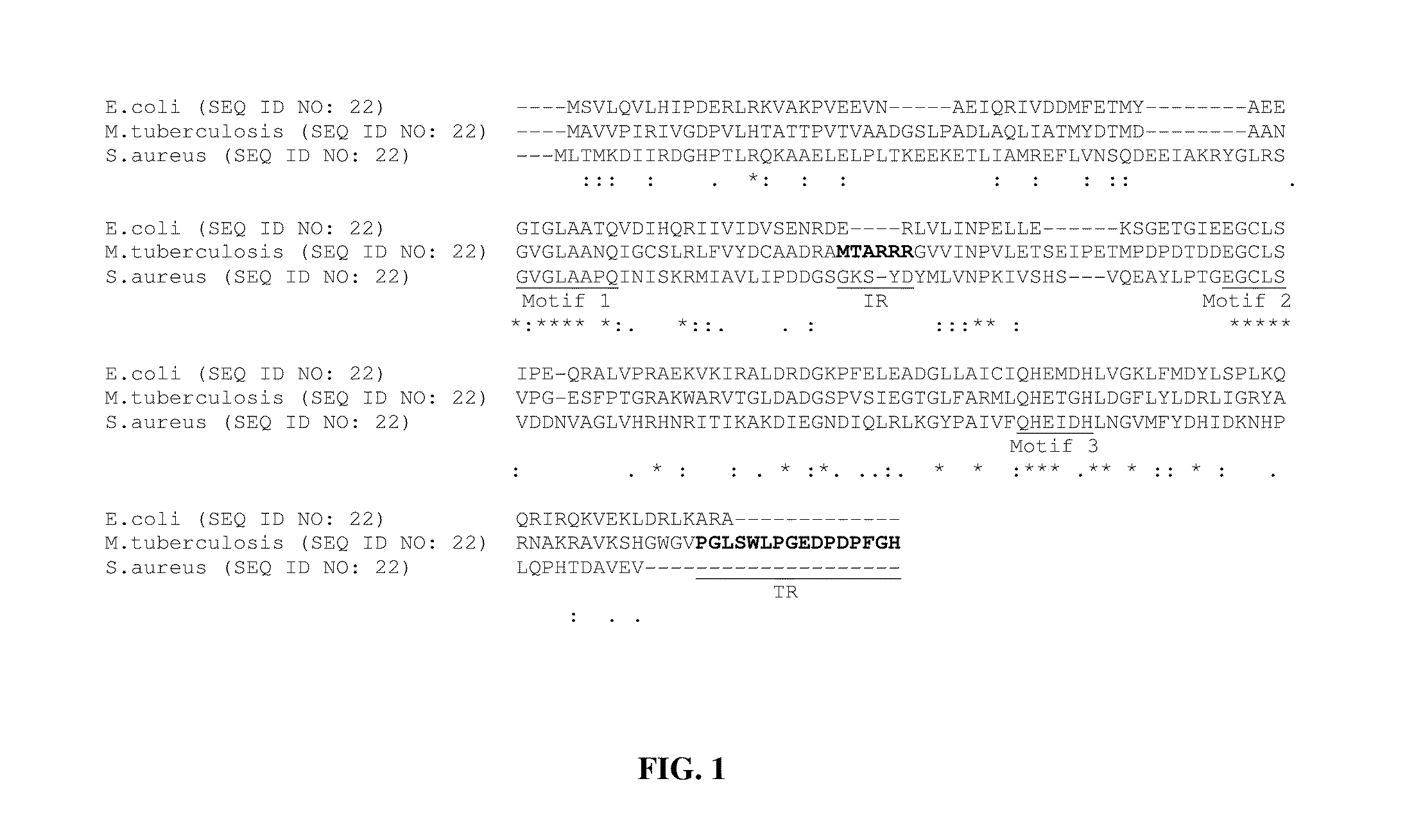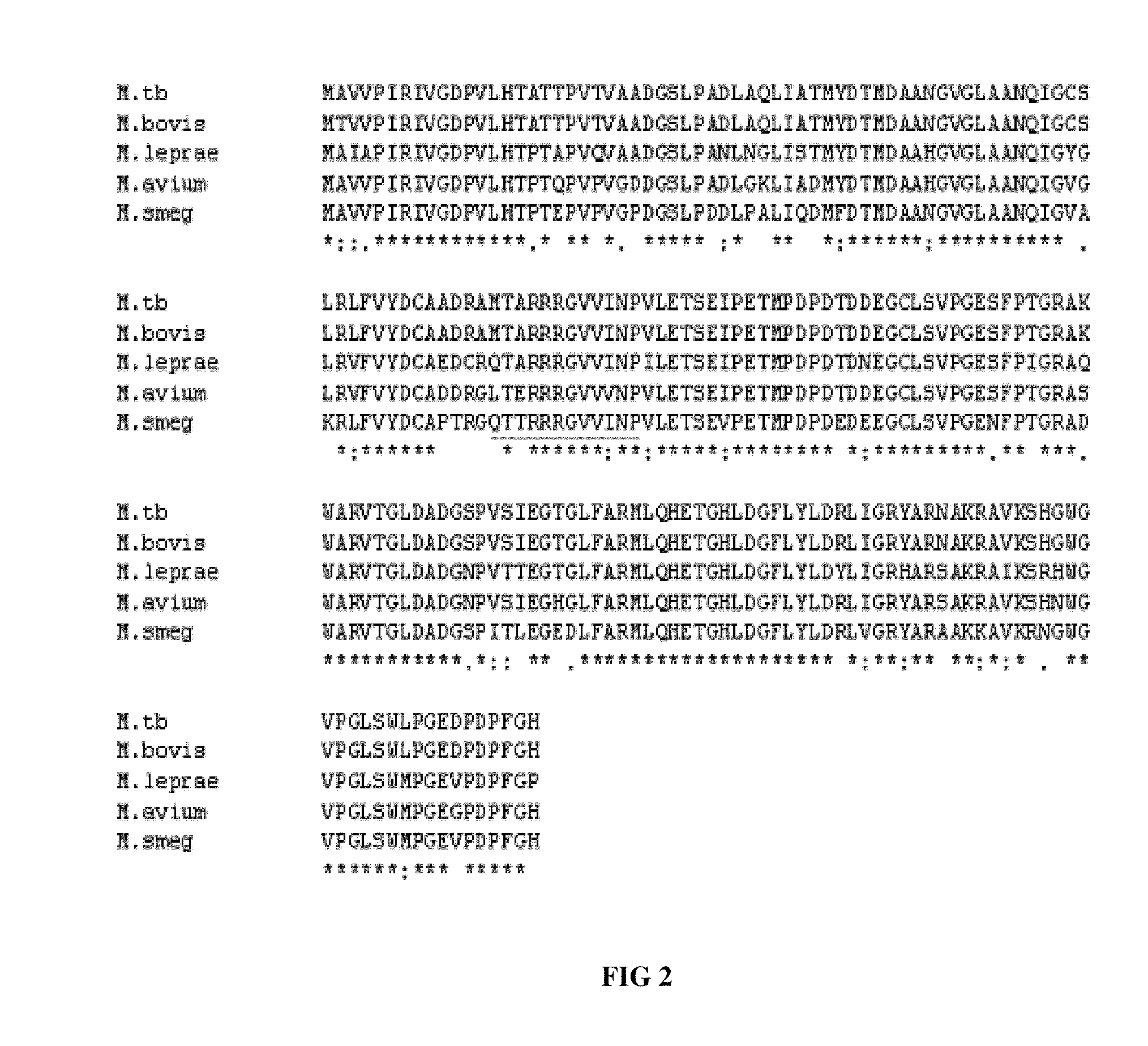Microbacterial Peptide Deformylase
a technology of peptide deformylase and microorganisms, which is applied in the direction of antibacterial agents, drug compositions, enzymology, etc., can solve the problems of widespread human mortality worldwide, drug resistance in pathogenic microorganisms is a great threat to public health, and the variety of targets for inhibiting it is very limited
- Summary
- Abstract
- Description
- Claims
- Application Information
AI Technical Summary
Benefits of technology
Problems solved by technology
Method used
Image
Examples
example 1
Nucleotide derived amino acid sequence of mPDF was compared with ‘nr’ database in BLAST-P programme using mail server at NIH (Altschul et al., Nucleic. Acids. Res. 25 3389-3402 1997). The multiple sequence alignments of the retrieved sequences were carried out using the Clustal X 1.81 program (Thompson et al., Nucleic. Acids. Res. 25: 4876-4882 1997.). Analyses of amino acid sequences of all eubacterial PDFs revealed the presence of three (I: GXGXAAXQ LSEQ ID NO: 27), II: EGCLS (SEQ ID NO: 28) and III: QHEXXH (SEQ ID NO: 29) where X is any hydrophobic residue) highly conserved motifs (FIG. 1), despite their broad categorization in the literature as type I (gram-negative) and type II (gram-positive) classes. We compared nucleotide derived amino acid sequence of mPDF with well-characterized representatives belonging to both type I (E. coli) and type II (Staphylococcus aureus) classes. Analysis of M. tuberculosis peptide deformylase sequence revealed that the mPDF possesses an insertio...
example 2
The def open reading frame (594 bp) was PCR amplified at annealing temperature of 50° C. using Genomic DNA from M. tuberculosis. Primers (CR1: 5′ CATATGGCAGTGGTACCC 3′ SEQ ID NO: 15 where NdeI site was incorporated and CR3: 5′ CCATTAGTGACCGAACGGG 3′ SEQ ID NO: 16) used were designed based on def (Rv0429c) sequence of published M. tuberculosis genome (Cole et al., Nature. 393 537-544 1998). The PCR was carried out using Expand long template PCR system (Roche) following manufacturer's recommended protocol.
Following treatment with DNA polymerase I (Klenow), the PCR-amplified fragment was initially cloned at SmaI site of pUC19 vector (pUC-mPDF) following standard protocols (Sambrook, J. and Russel, D. Molecular cloning: a Laboratory Manual. Cold Spring Harbor Laboratory Press, Cold spring Harbor, N.Y., USA 2001) and its nucleic acid sequence was determined using an automated sequencer (Applied Biosystems). Sequencing of this fragment following cloning in pUC19 indicated 100% identity at...
example 3
We further examined the contribution of this region on the growth profile of Mycobacterium smegmatis strain mc2155, a fast growing saprophyte which has often been used as a model for genetic studies of M. tuberculosis (Flint, et al., Proc. Natl. Acad. Sci. U S. A. 101, 12598-12603 2004). ˜1×105 cells of M. smegmatis (obtained from confluent culture and cell number adjusted by serial dilution) were incubated with 10 μM PS-ODN1 in 3 ml broth (7H9 Middlebrook media supplemented with 10% ADC). The PS-ODN1 was designed to span the region (bases 219-249 of M. tuberculosis def) mostly conserved in all mycobacterial species (˜73% homology at the nucleotide level between clefs of M. tuberculosis and M. smegmatis). Small aliquots were removed at different time intervals (0, 6, 12, 24 hr) and optical density at 600 nm was recorded to obtain a growth profile of bacterial cultures for treated and untreated with PS-ODN1. Simultaneously, the bacterial cells withdrawn at different time intervals we...
PUM
 Login to View More
Login to View More Abstract
Description
Claims
Application Information
 Login to View More
Login to View More - Generate Ideas
- Intellectual Property
- Life Sciences
- Materials
- Tech Scout
- Unparalleled Data Quality
- Higher Quality Content
- 60% Fewer Hallucinations
Browse by: Latest US Patents, China's latest patents, Technical Efficacy Thesaurus, Application Domain, Technology Topic, Popular Technical Reports.
© 2025 PatSnap. All rights reserved.Legal|Privacy policy|Modern Slavery Act Transparency Statement|Sitemap|About US| Contact US: help@patsnap.com



